Surface Hygiene Evaluation Method in Food Trucks as an Important Factor in the Assessment of Microbiological Risks in Mobile Gastronomy
Abstract
1. Introduction
2. Materials and Methods
2.1. Materials
2.2. Microbiological Methods
2.2.1. Reference Plate Method
2.2.2. Alternative Contact Method—Petrifilm
2.2.3. Interpretation of Culture Methods Results
2.2.4. ATP Bioluminescence Measurement
2.2.5. Interpretation of Bioluminescence Measurement Results
2.3. Statistical Methods
3. Results
3.1. Visual Assessment of the Surfaces in Street Food Outlets
3.2. Presence of Indicator Microorganisms on Surfaces in Street Food Outlets
3.2.1. Total Viable Count
3.2.2. Enterobacteriaceae and E. coli Bacteria
3.3. Presence of Pathogenic Microorganisms on Surfaces in Street Food Outlets
3.4. Evaluation of Hygiene in Street Food Outlets Using the ATP Method
3.5. Evaluation of the Suitability of Methods to Measure the State of Hygiene in Street Food Outlets
4. Discussion
4.1. Hygienic Status of Working Surfaces in Food Trucks
4.2. Comparison of Control Methods in Food Trucks
4.3. Limitations
5. Conclusions
Supplementary Materials
Author Contributions
Funding
Institutional Review Board Statement
Informed Consent Statement
Data Availability Statement
Conflicts of Interest
References
- Akinbode, S.O.; Dipeolu, A.O.; Okuneye, P.A. Willingness to Pay for Street Food Safety in Ogun State, Nigeria. J. Agric. Food Inf. 2011, 12, 154–166. [Google Scholar] [CrossRef]
- Czarniecka-Skubina, E.; Trafiałek, J.; Wiatrowski, M.; Głuchowski, A. An Evaluation of the Hygiene Practices of European Street Food Vendors and a Preliminary Estimation of Food Safety for Consumers, Conducted in Paris. J. Food Protect. 2018, 81, 1614–1621. [Google Scholar] [CrossRef] [PubMed]
- Wiatrowski, M.; Czarniecka-Skubina, E.; Trafiałek, J. Consumer eating behavior and their opinions about the food safety of street food in Poland. Nutrients 2021, 13, 594. [Google Scholar] [CrossRef]
- de Cardoso, C.V.R.; dos Santos, S.M.C.; Silva, E.O. Street food and intervention: Strategies and proposals to the developing world. Cien. Saude Colet. 2009, 14, 1215–1224. [Google Scholar] [CrossRef][Green Version]
- Choi, J.; Lee, A.; Ok, C. The Effects of Consumers’ Perceived Risk and Benefit on Attitude and Behavioral Intention: A Study of Street Food. J. Travel Tour. Mark. 2013, 30, 222–237. [Google Scholar] [CrossRef]
- Calloni, M. Street food on the move: A socio-philosophical approach. J. Sci. Food Agric. 2013, 93, 3406–3413. [Google Scholar] [CrossRef]
- Meher, M.M.; Afrin, M.; Talukder, A.K.; Golam Haider, M.G. Knowledge, attitudes and practices (KAP) of street food vendors on food safety in selected areas of Bangladesh. Heliyon 2022, 8, e12166. [Google Scholar] [CrossRef]
- Isanovic, S.; Constantinides, S.V.; Frongillo, E.A.; Bhandari, S.; Samin, S.; Kenney, E.; Wertheim-Heck, S.; Nordhagen, S.; Holdsworth, M.; Dominguez-Salas, P.; et al. How perspectives on food safety of vendors and consumers translate into food choice behaviors in six African and Asian countries. Curr. Dev. Nutr. 2022, 7, 100015. [Google Scholar] [CrossRef]
- Khairuzzaman, M.; Chowdhury, F.M.; Zaman, S.; Al Mamun, A.; Bari, M.L. Food Safety Challenges towards Safe, Healthy, and Nutritious Street Foods in Bangladesh. Int. J. Food Sci. 2014, 2014, 483519. [Google Scholar] [CrossRef]
- Lucan, S.C.; Maroko, A.R.; Bumol, J.; Varona, M.; Torrens, L.; Schechter, C.B. Mobile food vendors in urban neighborhoods-implications for diet and diet-related health by weather and season. Health Place 2014, 27, 171–175. [Google Scholar] [CrossRef]
- Dal, R.; Cortese, M.; Boro, M.; Feldman, C.; Barletto, S. Food safety and hygiene practices of vendors during the chain of street food production in Florianopolis, Brazil: A cross-sectional study. Food Control 2016, 62, 178–186. [Google Scholar] [CrossRef]
- Chukuezi, O. Food Safety and Hyienic Practices of Street Food Vendors in Owerri, Nigeria. Stud. Sociol. Sci. 2010, 1, 50–57. [Google Scholar]
- Orlando, D.; Suci Hardianti, M.; Sigit Setyabudi, F.M.C. Mounting and effective response an outbreak of viral disease involving street food vendors in Indonesia. In Case Studies in Food Safety and Authenticity. Lessons from Real-Life Situations; Woodhead Publishing: Southton, UK, 2012; pp. 161–167. [Google Scholar]
- Al Mamun, M.; Rahman, S.M.M.; Turin, T.C. Microbiological quality of selected street food items vended by school-based street food vendors in Dhaka, Bangladesh. Int. J. Food Microbiol. 2013, 166, 413–418. [Google Scholar] [CrossRef]
- Aluko, O.O.; Ojeremi, T.T.; Ajidagba, E.B. Evaluation of food safety and sanitary practices among food vendors at car parks in Ile Ife, southwestern Nigeria. Food Control 2014, 40, 165–171. [Google Scholar] [CrossRef]
- Liu, Z.; Zhang, G.; Zhang, X. Urban street foods in Shijiazhuang city, China: Current status, safety practices and risk mitigating strategies. Food Control 2014, 41, 212–218. [Google Scholar] [CrossRef]
- Campos, J.; Gil, J.; Mourão, J.; Peixe, L.; Antunes, P. Ready-to-eat street-vended food as a potential vehicle of bacterial pathogens and antimicrobial resistance: An exploratory study in Porto region, Portugal. Int. J. Food Microbiol. 2015, 206, 1–6. [Google Scholar] [CrossRef] [PubMed]
- Alimi, B.A. Risk factors in street food practices in developing countries: A review. Food Sci. Hum. Wellness 2016, 5, 141–148. [Google Scholar] [CrossRef]
- Kothe, C.I.; Schild, C.H.; Tondo, E.C.; da Silva Malheiros, P. Microbiological contamination and evaluation of sanitary conditions of hot dog street vendors in Southern Brazil. Food Control 2016, 62, 346–350. [Google Scholar] [CrossRef]
- Trafialek, J.; Drosinos, E.H.; Kolanowski, W. Evaluation of street food vendors’ hygienic practices using fast observation questionnaire. Food Control 2017, 80, 350–359. [Google Scholar] [CrossRef]
- Trafialek, J.; Drosinos, E.H.; Laskowski, W.; Jakubowska-Gawlik, K.; Tzamalis, P.; Leksawasdi, M.; Surawang, S.; Kolanowski, W. Street food vendors’ hygienic practices in some Asian and EU countries—A survey. Food Control 2018, 85, 212–222. [Google Scholar] [CrossRef]
- Kolanowski, W.J.; Trafialek, E.H.; Drosinos, P.; Tzamalis, P.G. Polish and Greek young adults ’ experience of low quality meals when eating out. Food Control 2020, 109, 106901. [Google Scholar] [CrossRef]
- Qureshi, S.; Vaida, N.; Azim, H. Hygiene practices and food safety knowledge among street food vendors in Kashmir. Int. J. Sci. Res. 2016, 4, 723–726. [Google Scholar] [CrossRef]
- Wiatrowski, M.; Czarniecka-Skubina, E.; Trafialek, J.; Rosiak, E. An Evaluation of the Hygiene Practices of Polish Street Food Vendors—On an example of food trucks and stands. Foods 2021, 10, 2640. [Google Scholar] [CrossRef]
- Abid, M.T.; Banna, M.H.A.; Hamiduzzaman, M.; Seidu, A.-A.; Kundu, S.; Rezyona, H.; Disu, T.R.; Akter, N.; Khadleduzzaman, M.; Ahinkorah, B.O.; et al. Assessment of food safety knowledge, attitudes and practices of street food vendors in Chattogram city, Bangladesh: A cross-sectional study. Public Health Chall. 2022, 1, e16. [Google Scholar] [CrossRef]
- Burt, B.M.; Volel, C.; Finkel, M. Safety of vendor-prepared foods: Evaluation of 10 processing mobile food vendors in Manhattan. Public Health Rep. 2003, 118, 470–476. [Google Scholar] [CrossRef] [PubMed]
- WHO. Basic steps to improve safety of street-vended food. INFOSAN Inf. Note 2010, 3, 1–5. Available online: https://www.yumpu.com/en/document/view/5302144/basic-steps-to-improve-safety-of-street-vended-food (accessed on 12 December 2022).
- Dun-Dery, E.J.; Addo, H.O. Food hygiene awareness, processing and practice among street food vendors in Ghana. Food Public Health 2016, 6, 65–74. [Google Scholar] [CrossRef]
- McKay, F.H.; Singh, A.; Singh, S.; Good, S.; Osborne, R.H. Street vendors in Patna, India: Understanding the socio-economic profile, livelihood and hygiene practices. Food Control 2016, 70, 281–285. [Google Scholar] [CrossRef]
- Tomar, R.S.; Gupta, M.; Kaushik, S.; Mishra, R.K. Bacteriological Quality of Panipuri in Historical Gwalior City (MP), India. Asian J. Pharm. 2018, 12, 329. [Google Scholar] [CrossRef]
- Abraham, S.; Krishnan, T.A. An Analysis of How Street Food in India can be made Safe Food. IJCESR 2017, 4, 57–64. [Google Scholar]
- Islam, N.; Arefin, S.; Nigar, T.; Haque, S.N.; Haq, K.I.; Emran, T.A.; Nazrul, T. Street food eating habits in Bangladesh: A study on Dhaka city. Int. J. Manag. Dev. Stud. 2017, 6, 49–57. [Google Scholar]
- Rosales, A.P.; Linnemann, A.R.; Luning, P.A. Food safety knowledge, self-reported hygiene practices, and street food vendors’ perceptions of current hygiene facilities and services—An Ecuadorean case. Food Control 2023, 144, 109377. [Google Scholar] [CrossRef]
- Azanaw, J.; Engdaw, G.T.; Dejene, H.; Bogale, S.; Degu, S. Food hygiene knowledge, and practices and their associated factors of street food vendors in Gondar city, Northwest Ethiopi. A cross-sectional study. Heliyon 2022, 8, e11707. [Google Scholar] [CrossRef] [PubMed]
- FAO—Food and Agriculture Organization of the United Nations. Food for the Cities: Street Foods. 2019. Available online: https://www.fao.org/fcit/food-processing/street-foods/en/ (accessed on 13 May 2022).
- CDC—Centers for Disease Control and Prevention. Surveillance for Foodborne Disease Outbreaks, United States, 2015, Annual Report. US Department of Health and Human Services. 2017. Available online: https://www.cdc.gov/foodsafety/pdfs/2015foodborneoutbreaks_508.pdf (accessed on 13 May 2022).
- Mosupye, F.M.; Von Holy, A. Microbiological hazard identification and exposure assessment of street food vending in Johannesburg, South Africa. Int. J. Food Microbiol. 2000, 61, 137–145. [Google Scholar] [CrossRef] [PubMed]
- Hanashiro, A.; Morita, M.; Matté, G.R.; Matté, M.H.; Torres, E.A.F.S. Microbiological quality of selected street foods from a restricted area of São Paulo City, Brazil. Food Control 2005, 16, 439–444. [Google Scholar] [CrossRef]
- Gadaga, T.H.; Samende, B.K.; Musuna, C.; Chibanda, D. The microbiological quality of informally vended foods in Harare, Zimbabwe. Food Control 2008, 19, 829–832. [Google Scholar] [CrossRef]
- Nyenje, M.E.; Odjadjare, C.E.; Tanih, N.F.; Green, E.; Ndip, R.N. Foodborne pathogens recovered from ready-to-eat foods from roadside cafeterias and retail outlets in alice, eastern cape province, South Africa: Public health implications. Int. J. Environ. Res. Public Health 2012, 9, 2608–2619. [Google Scholar] [CrossRef]
- Adjrah, Y.; Soncy, K.; Anani, K.; Blewussi, K.; Karou, D.S.; Ameyapoh, Y.; de Souza, C.; Gbeassor, M. Socio-economic profile of street food vendors and microbiological quality of ready-to-eat salads in Lomé. Int. Food Res. J. 2013, 20, 65–70. [Google Scholar]
- Nkah, G. Evaluation de la Qualité Microbiologique Du Maquereau á la Braise Commercialisé Dans Quelques Quartiers de la Ville de Douala; Mémoire d’Ingénieur, Institut des Sciences Halieutiques de Yabassi, Université de Douala: Douala, Cameroon, 2017; pp. 1–66. [Google Scholar]
- Achondi, C. Study on the Factors Affecting the Contamination of Roasted Mackerel within the Town of Douala. Ph.D. Thesis, Institute of Fisheries and Aquatic Sciences of Yabassi, University of Douala, Douala, Cameroon, 2018; pp. 1–74. [Google Scholar]
- Nguendo Yongsi, H.B. Eating to live or eating to damage one’s health: Microbiological risks associated with street-vended foods in a subtropical urban setting (Yaounde-Cameroon). Nutr. Food Sci. Int. J. 2018, 6, 555695. [Google Scholar] [CrossRef]
- Tchigui Manga Maffouo, S.; Tene Mouafo, H.; Simplice Mouokeu, R.; Manet, L.; Kamgain Tchuenchieu, A.; Noutsa Simo, B.; Tchuitcheu Djeuachi, H.; Nama Medoua, G.; Tchoumbougnang, F. Evaluation of sanitary risks associated with the consumption of street food in the city of Yaoundé (Cameroon): Case of braised fish from Mvog-Ada, Ngoa Ekélé, Simbock, Ahala and Olézoa. Heliyon 2021, 7, e07780. [Google Scholar] [CrossRef]
- Alfred, K.K.; Jean-Paul, B.K.M.; Hermann, C.W.; Mirelle, B.A.; Marcellin, D.K. Assessment of safety risks associated with pork meat sold on the market in Abidjan city (Cote d’Ivoire) using surveys and microbial testing. Heliyon 2019, 5, e02172. [Google Scholar] [CrossRef]
- Aovare, O.P.; Kendie, S.B.; Osei-Kufuorp, P. Safety Assessment of Street Foods in The Bolgatanga Municipality of The Upper East Region, Ghana. JAFSAT 2022, 9, 21–34. [Google Scholar]
- Cardinale, E.; Gros-Claude, J.P.; Tall, F.; Gueye, E.; Salvat, G. Risk factors for contamination of ready-to-eat street-vended poultry dishes in Dakar, Senegal. Int. J. Food Microbiol. 2005, 103, 157–165. [Google Scholar] [CrossRef] [PubMed]
- Ologhobo, A.; Omojola, A.; Ofongo, S.; Moiforay, S.; Jibir, M. Safety of street vended meat products-chicken and beef suya. Afr. J. Biotechnol. 2010, 9, 4091–4095. [Google Scholar]
- Kigigha, L.T.; Ovunda, H.; Izah, S. Microbiological quality assessment of suya sold in Yenegoa Metropolis, Nigeria. J. Adv. Biol. Basic Res. 2015, 1, 105–109. [Google Scholar]
- Dagalea, F.M.S.; Lim, K.M.C.; Vicencio, M.C.G.; Ballicud, J.J.C.; Burac, M.R.B.; Vibar, J.J.B.; Villadolid, V.B.E. Are street foods safe: Detection of escherichia coli in street foods sauces. S. Asian J. Res. Microbiol. 2021, 9, 41–45. [Google Scholar] [CrossRef]
- Savvaidis, I.N.; Al Katheeri, A.; Lim, S.-H.E.; Lai, K.-S.; Abushelaibi, A. Traditional Foods, Food Safety Practices, and Food Culture in the Middle East, Chapter 1. In Food Safety in the Middle East; Academic Press: Cambridge, MA, USA, 2022; pp. 1–31. [Google Scholar] [CrossRef]
- Ali, A.; Ahmad, N.; Liaqat, A.; Farooq, M.A.; Ahsan, S.; Chughtai, M.F.J.; Rahaman, A.; Saeed, K.; Junaid-ur-Rahman, S.; Siddeeg, A. Safety and quality assessment of street-vended barbecue chicken samples from Faisalabad, Pakistan. Food Sci. Nutr. 2022. online ahead of print. [Google Scholar] [CrossRef]
- Nkere, C.K.; Ibe, N.I.; Iroegbu, C.U. Bacteriological Quality of Foods and Water Sold by Vendors and in Restaurants in Nsukka, Enugu State, Nigeria: A Comparative Study of Three Microbiological Methods. J. Health Popul. Nutr. 2011, 29, 560–566. [Google Scholar] [CrossRef] [PubMed][Green Version]
- Willis, C.; Elviss, N.; Aird, H.; Fenelon, D.; McLauchlin, J. Evaluation of hygiene practices in catering premises at large-scale events in the UK: Identifying risks for the Olympics 2012. Public Health 2012, 126, 646–656. [Google Scholar] [CrossRef] [PubMed]
- Enoch, D.A.; Mlangeni, D.A.; Ekundayo, J.; Aliyu, M.; Sismey, A.W.; Aliyu, S.H.; Karas, A. Gram negative bacteraemia-are they preventable and what will E. coli surveillance add? J. Infect. Prev. 2013, 14, 55–59. [Google Scholar] [CrossRef]
- Martinon, A.; Cronin, U.P.; Quealy, J.; Stapleton, A.; Wilkinson, M.G. Swab sample preparation and viable real-time PCR methodologies for the recovery of Escherichia coli, Staphylococcus aureus or Listeria monocytogenes from artificially contaminated food processing surfaces. Food Control 2012, 24, 86–94. [Google Scholar] [CrossRef]
- Mead, G.C. Poultry Meat Processing and Quality; Woodhead Publishing Series in Food Science, Technology and Nutrition: Cambridge, UK, 2004; pp. 232–257. [Google Scholar]
- Waliullah, S.; Ahsan, C.R. Assessment of Microbiological Quality of Some Meat-Based Fast Foods Collected From Street Vendors. J. Innov. Dev. Strategy 2011, 5, 44–46. [Google Scholar]
- Manguiat, L.S.; Fang, T.J. Microbiological quality of chicken and pork-based street-vended foods from Taichung, Taiwan, and Laguna Philippines. Food Microbiol. 2013, 36, 57–62. [Google Scholar] [CrossRef] [PubMed]
- Annan-Prah, A.; Amewowor, D.H.A.K.; Osei-Kofi, J.; Amoono, S.E.; Akorli, S.Y.; Saka, E.; Ndadi, H.A. Street foods: Handling, hygiene and client expectations in a World Heritage Site Town, Cape Coast, Ghana. Afr. J. Micriol. Res. 2011, 5, 1629–1634. [Google Scholar] [CrossRef]
- Dabbagh-Zadeh, R.; Hashemi, M.; Massah, M.; Taherian, E.; Sayyahi, N.; Haghparasti, F.; Marhamati, M.; Alavi, L.; Bahrami, N.; Katami, M.; et al. Microbiological and Chemical Properties of Falafel Samples Collected From Street Market in Ahvaz, Iran. Jundishapur J. Med. Sci. 2022, 21, 68–79. [Google Scholar] [CrossRef]
- Jaja, I.F.; Green, E.; Muchenje, V. Aerobic mesophilic, coliform, Escherichia coli, and Staphylococcus aureus counts of raw meat from the formal and informal meat sectors in South Africa. Int. J. Environ. Res. Public Health 2018, 15, 819. [Google Scholar] [CrossRef]
- Odwar, J.A.; Kikuvi, G.; Kariuki, J.N.; Kariuki, S. A cross sectional study on the microbiological quality and safety of raw chicken meats sold in Nairobi, Kenya. BMC Res. Notes 2014, 7, 627. [Google Scholar] [CrossRef]
- Girmay, A.M.; Mengesha, S.D.; Weldetinsae, A.; Alemu, Z.A.; Dinsa, D.A.; Wagari, B.; Weldegebriel, M.G.; Serte, M.G.; Alemayehu, T.A.; Kenea, M.A.; et al. Factors associated with food safety practice and drinking-water quality of food establishments in Bishoftu Town, Ethiopia. Discov. Food 2022, 2, 35. [Google Scholar] [CrossRef]
- Bhattacharjya, H.; Reang, T. Safety of street foods in Agartala, North East India. Public Health 2014, 128, 746–748. [Google Scholar] [CrossRef] [PubMed]
- Parker, J.A.; Kurien, T.T.; Huppatz, C. Hepatitis A outbreak associated with kava drinking. Commun. Dis. Intell. Q. Rep. 2014, 38, E26–E28. [Google Scholar]
- Samapundo, S.; Climat, R.; Xhaferi, R.; Devlieghere, F. Food safety knowledge, attitudes and practices of street food vendors and consumers in Port-au-Prince, Haiti. Food Control 2015, 50, 457–466. [Google Scholar] [CrossRef]
- Evans, J.A.; Russell, S.L.; James, C.; Corry, J.E.L. Microbial contamination of food refrigeration equipment. J. Food Eng. 2004, 62, 225–232. [Google Scholar] [CrossRef]
- Christon, C.A.; Lindsay, D.; Von Holy, A. Microbiological survey of ready- to-eat foods and associated preparation surfaces in retail delicatessens Johannesburg, South Africa. Food Control 2008, 19, 727–733. [Google Scholar] [CrossRef]
- Rodriguez, M.; Valero, A.; Posada-Izquierdo, G.D.; Carrasco, E.; Zurera, G. Evaluation of food handler practices and mirobiological status of ready-to-eat foods in long-term care facilities in Andalusia region of Spain. J. Food Protect. 2011, 74, 1504–1512. [Google Scholar] [CrossRef] [PubMed]
- Cunningham, A.E.; Rajagopal, R.; Lauer, J.; Allwood, P. Assessment of hygienic quality of surfaces in retail food service establishments based on microbial counts and real-time detection of ATP. J. Food Protect. 2011, 74, 686–690. [Google Scholar] [CrossRef] [PubMed]
- Lahou, E.; Jacxsens, L.; Daelman, J.; Van Landeghem, F.; Uyttendaele, M. Microbiological Performance of a Food Safety Management System in a Food Service Operation. J. Food Protect. 2012, 75, 706–716. [Google Scholar] [CrossRef]
- Czarniecka-Skubina, E. Ocena ryzyka zdrowotnego w zakładach gastronomicznych na wybranych przykładach (Health Risk Assessment in Catering Establishments Based on the Selected Examples); Treatises and Monographs; WULS-SGGW: Warsaw, Poland, 2013. [Google Scholar]
- PN-ISO-18593:2018; Microbiology of food and animal feeding stuffs—Horizontal methods for sampling techniques from surfaces using contact plates and swabs. ISO: Geneva, Switzerland, 2018.
- ISO 4833-2:2013/Amd 1:2022; Microbiology of the food chain—Horizontal method for the enumeration of microorganisms—Part 2: Colony count at 30 °C by the surface plating technique. ISO: Geneva, Switzerland, 2022.
- PN-EN ISO 6888-2:2001/A1:2004; Horizontal method for the enumeration of coagulase-positive staphylococci (Staphylococcus aureus and other species)—Part 2: Method using rabbit plasma fibrinogen agar medium. ISO: Geneva, Switzerland, 2004.
- PN-EN ISO 21528-2:2017; Microbiology of the food chain—Horizontal method for the detection and enumeration of Enterobacteriaceae—Part 2: Colony-count technique. ISO: Geneva, Switzerland, 2017.
- ISO 16649-3:2015; Microbiology of the food chain—Horizontal method for the enumeration of beta-glucuronidase-positive Escherichia coli—Part 3: Detection and most probable number technique using 5-bromo-4-chloro-3-indolyl-ß-D-glucuronide. ISO: Geneva, Switzerland, 2015.
- PN-EN ISO 11290-1:2017; Microbiology of the food chain—Horizontal method for the detection and enumeration of Listeria monocytogenes and of Listeria spp.—Part 1: Detection method. ISO: Geneva, Switzerland, 2017.
- PN-EN ISO 6579-1:2017; Microbiology of the food chain—Horizontal method for the detection, enumeration and serotyping of Salmonella—Part 1: Detection of Salmonella spp. ISO: Geneva, Switzerland, 2017.
- Moore, G.; Griffith, C.J. A comparison of traditional and recently developed methods for monitoring surface hygiene within the food industry: An industry trial. Int. J. Environ. Health Res. 2002, 12, 317–329. [Google Scholar] [CrossRef]
- Griffith, C.J.; Cooper, R.A.; Gilmore, J.; Davies, C.; Lewis, M. An evaluation of hospital regimes and standards. J. Hosp. Infect. 2000, 45, 19–28. [Google Scholar] [CrossRef]
- StatSoft, Inc. STATISTICA (Data Analysis Software System), 2011, Version 13.3. Available online: http://www.statsoft.com (accessed on 4 August 2022).
- Dancer, S.J. How Do We Assess Hospital Cleaning? A Proposal for Microbiological Standards for Surfaces Hygiene in Hospital. J. Hosp. Infect. 2004, 56, 10–15. [Google Scholar] [CrossRef]
- Cooper, R.A.; Griffith, C.J.; Malik, R.E.; Obee, P.; Looker, N. Monitoring the effectiveness of cleaning in four British hospitals. Am. J. Infect. Control 2007, 35, 338–341. [Google Scholar] [CrossRef]
- Lewis, K.; Arnott, W.P.; Moosmüller, H.; Wold, C.E. Strong spectral variation of biomass smoke light absorption and single scattering albedo observed with a novel dual-wavelength photoacoustic instrument. J. Geophys. Res. 2008, 113, D16203. [Google Scholar] [CrossRef]
- Tebbutt, G.; Bell, V.; Aislabie, J. Verification of cleaning efficiency and its possible role in programmed hygiene inspections of food businesses undertaken by local authority officers. J. Appl. Microbiol. 2007, 102, 1010–1017. [Google Scholar] [CrossRef] [PubMed]
- Griffith, C.J. Food Safety in Catering Establishments. In Safe Handling of Foods; Farber, J.M., Todd, E.C.D., Eds.; Marcel Dekker: New York, NY, USA, 2000; pp. 235–256. [Google Scholar]
- Yepiz-Gomez, M.S.; Bright, K.R.; Gerba, C.P. Indentity and numbers of bacteria present on tabletops and in dishcloths used to wipe down tabletops in public restaurants and bars. Food Protec. Trends 2006, 26, 786–792. [Google Scholar]
- Bolton, D.J.; Meally, A.; Blair, I.S.; Mcdowell, D.A.; Cowan, C. Food safety knowledge of head chefs and catering managers in Ireland. Food Control 2008, 19, 291–300. [Google Scholar] [CrossRef]
- Legnani, P.; Leoni, E.; Berveglieri, M.; Mirolo, G.; Alvaro, N. Hygienic control of mass catering establishments, microbiological monitoring of food and equipment. Food Control 2004, 15, 205–211. [Google Scholar] [CrossRef]
- Todd, E.C.D.; Greig, J.D.; Bartleson, C.A.; Michaels, B.S. Outbreaks where food workers have been implicated in the spread of foodborne disease. Part 6. Transmission and survival of pathogens in the food processing and preparation environment. J. Food Protect. 2009, 72, 202–219. [Google Scholar] [CrossRef]
- Campdepadros, M.; Stchigel, A.M.; Romeu, M.; Quilez, J.; Sola, R. Effectiveness of two sanitation procedures for decreasing the microbial contamination levels (including Listeria monocytogenes) on food contact and non-food contact surfaces in a dessert-processing factory. Food Control 2012, 23, e31. [Google Scholar] [CrossRef]
- Lee, J.; Cartwright, R.; Grueser, T.; Pascall, M.A. Efficiency of manual dishwashing conditions on bacterial survival on eating utensils. J. Food Eng. 2007, 80, 885–891. [Google Scholar] [CrossRef]
- Phlillips, M.L.; Elledge, B.L.; Basara, H.G.; Lynch, R.A.; Boatright, D.T. Recurrent critical violations of the food code in retail food service establishments. J. Environ. Health 2006, 68, 24–30. [Google Scholar]
- Reske, K.A.; Jenkins, T.; Fernandez, C.; Vanamber, D.; Hedberg, C.W. Beneficial effects of implementing an announced restaurant inspection program. J. Environ. Health 2007, 69, 27–34. [Google Scholar]
- Garayoa, R.; Abundancia, C.; Díez-Leturia, M.; Vitas, A.I. Essential tools for food safety surveillance in catering services: On-site inspections and control of high risk cross-contamination surfaces. Food Control 2017, 75, 48–54. [Google Scholar] [CrossRef]
- Saada, M.; Seea, T.P.; Abdullahb, M.F.F.; Nor, N.M. Use of Rapid Microbial Kits for Regular Monitoring of Food-Contact Surfaces towards Hygiene Practices. Procedia Soc. Behav. Sci. 2013, 105, 273–283. [Google Scholar] [CrossRef]
- Tomasevic, I.; Kuzmanovic, J.; Andelkovic, A.; Saračević, M.; Stojanović, M.M.; Djekic, I. The effects of mandatory HACCP implementation on microbiological indicators of process hygiene in meat processing and retail establishments in Serbia. Meat Sci. 2016, 114, 54–57. [Google Scholar] [CrossRef] [PubMed]
- Larson, E.L.; Aiello, A.E.; Gomez-Duarte, C.; Lin, S.X.; Lee, L.; Della-Latta, P.; Lindhart, C. Bioluminescence ATP monitoring as a surrogate marker for microbial load on hands and surfaces in the home. Food Microbiol. 2003, 20, 735–739. [Google Scholar] [CrossRef]
- Rosiak, E.; Czarniecka-Skubina, E.; Wachowicz, I.; Kołożyn-Krajewska, D. Rapid Diagnostic methods for monitoring hygienic conditions in the food production, chapter 6. In Production Engineering; Borkowski, S., Ulewicz, R., Eds.; Novosibirsk State Technical University: Novosibirsk, Russia, 2009; pp. 57–66. [Google Scholar]
- Aycicek, H.; Oguz, U.; Karci, K. Comparison of results of ATP bioluminescence and traditional hygiene swabbing methods for the determination of surface cleanliness at a hospital kitchen. Int. J Hyg. Environ. Health 2006, 209, 203–206. [Google Scholar] [CrossRef] [PubMed]
- Hooker, E.A.; Allen, S.D.; Gray, L.D. Comparison of Rayon-Tip Swabs and film plates for use in collecting and quantifying bacteria on hospital bed mattresses. Am. J. Infect. Control 2011, 39, E191–E192. [Google Scholar] [CrossRef]
- Okumus, B.; Sonmez, S. An analysis on current food regulations for and inspection challenges of street food: Case of Florida. J. Culin. Sci. Technol. 2019, 17, 209–223. [Google Scholar] [CrossRef]
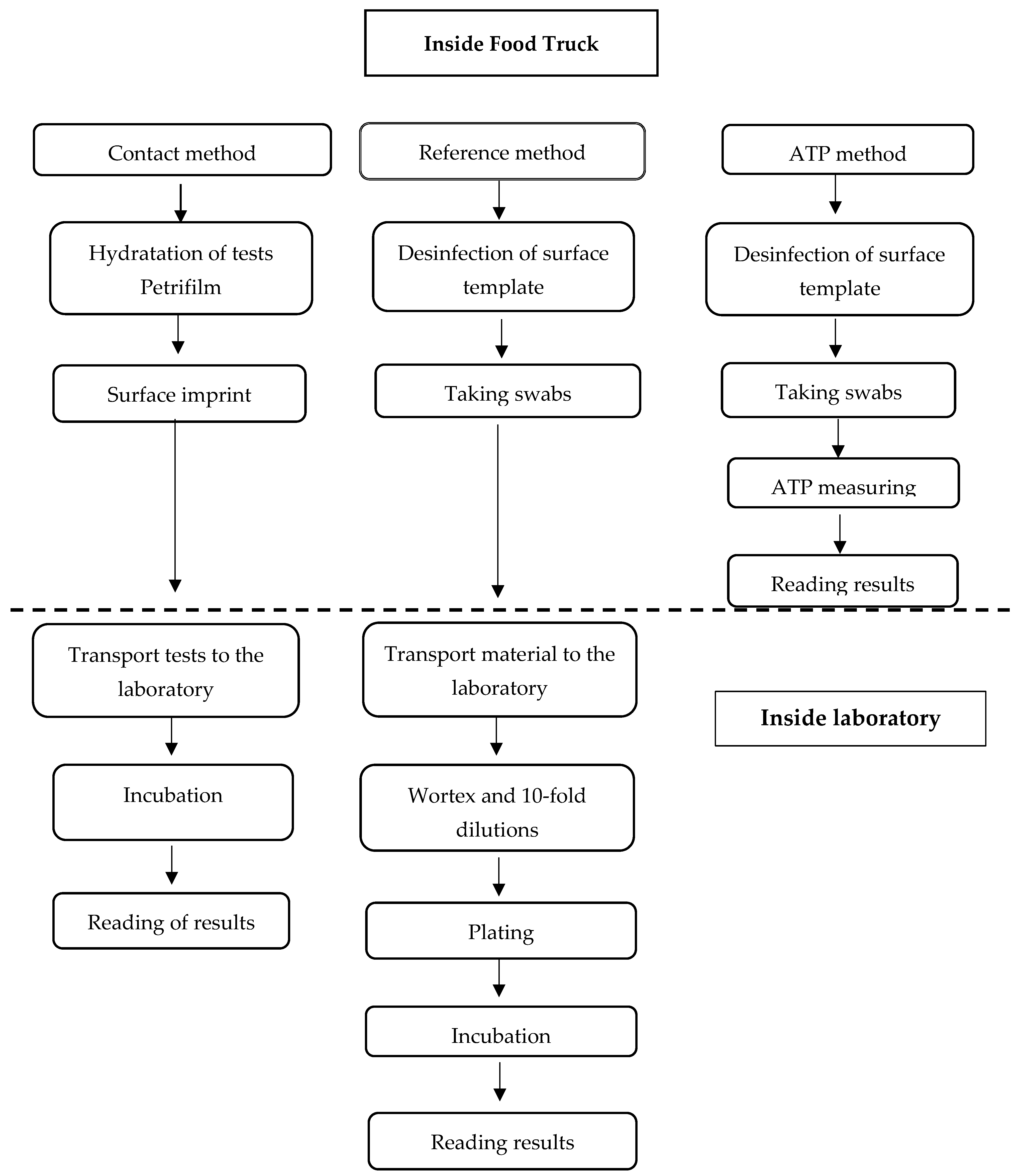
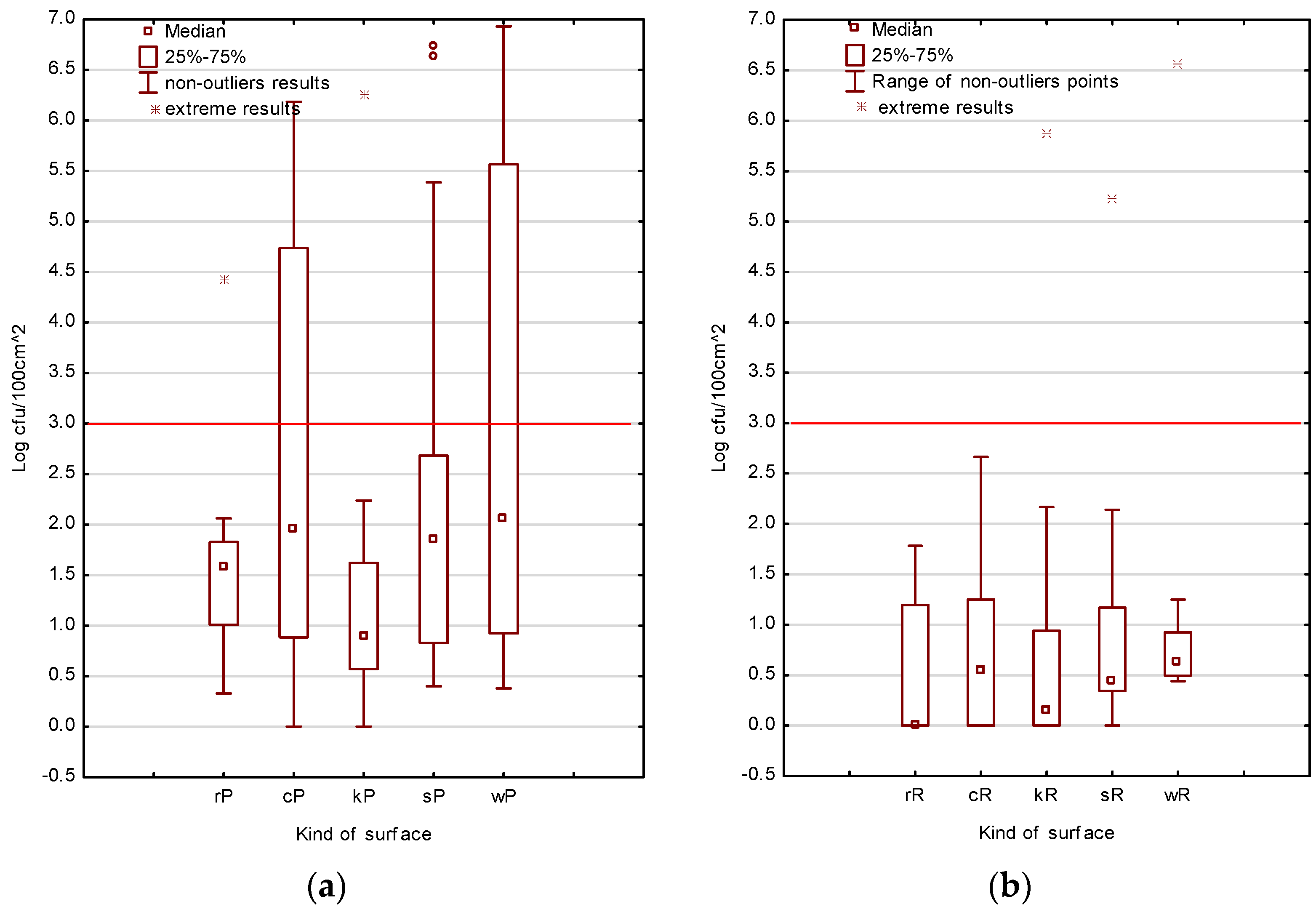
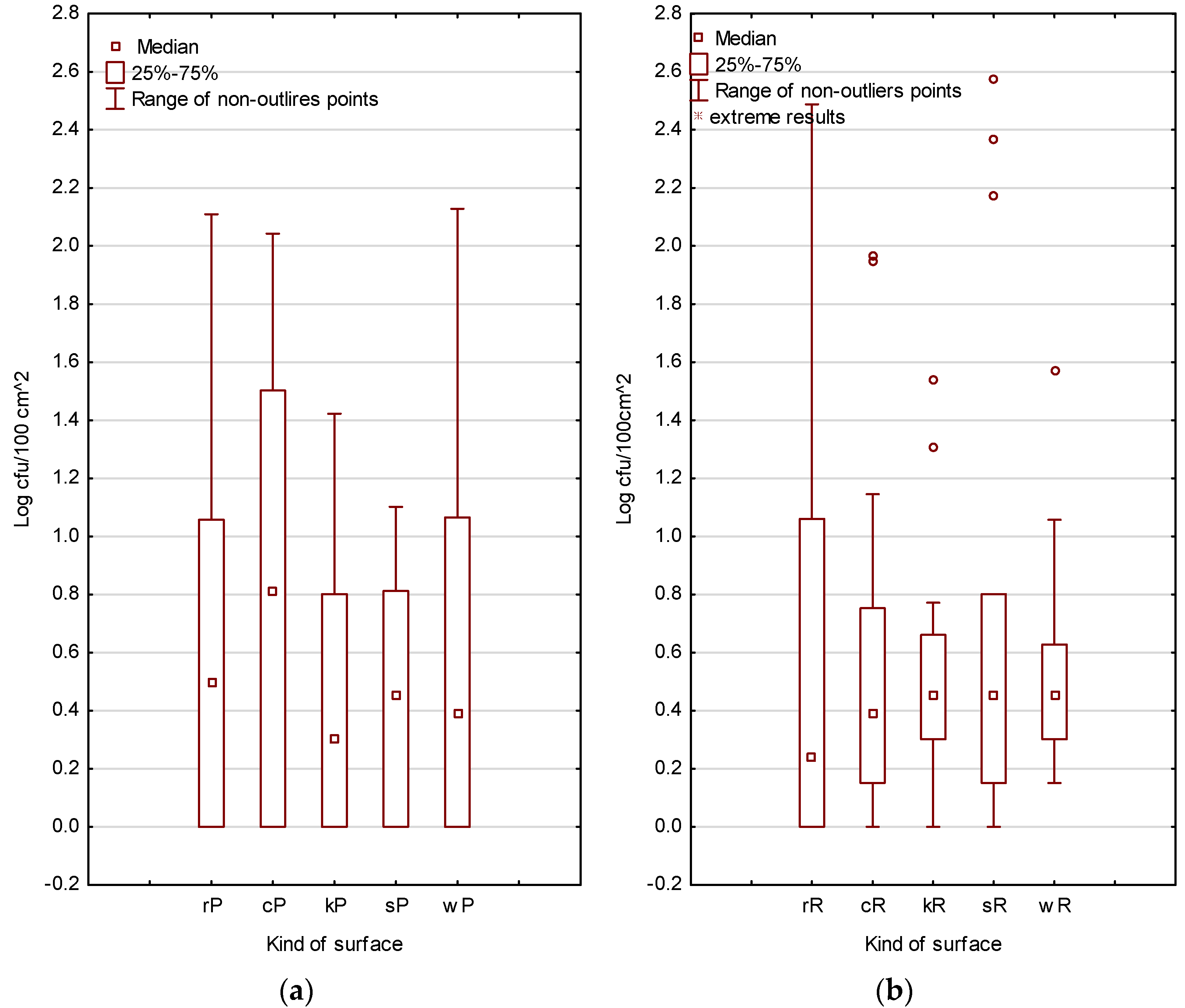
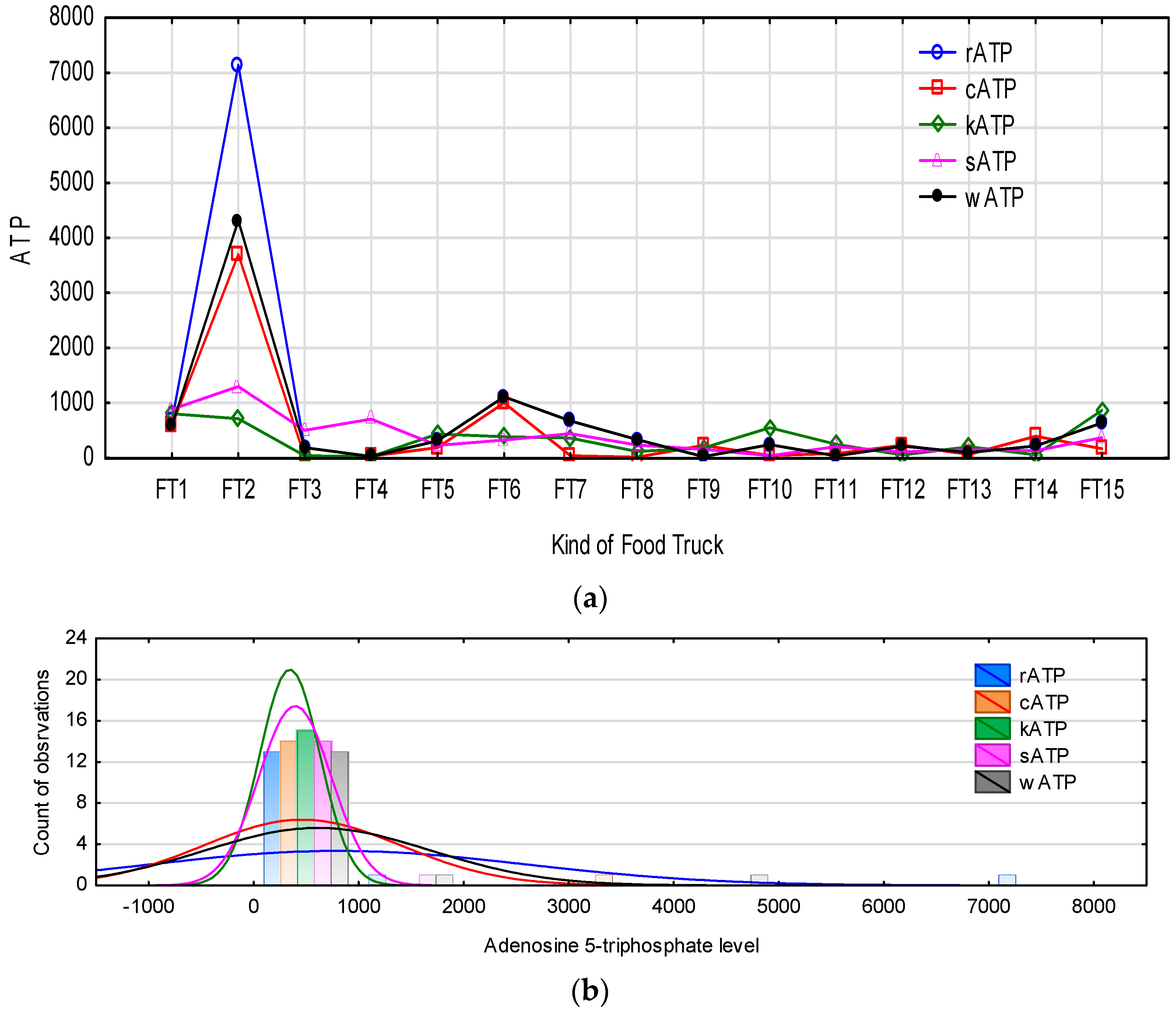
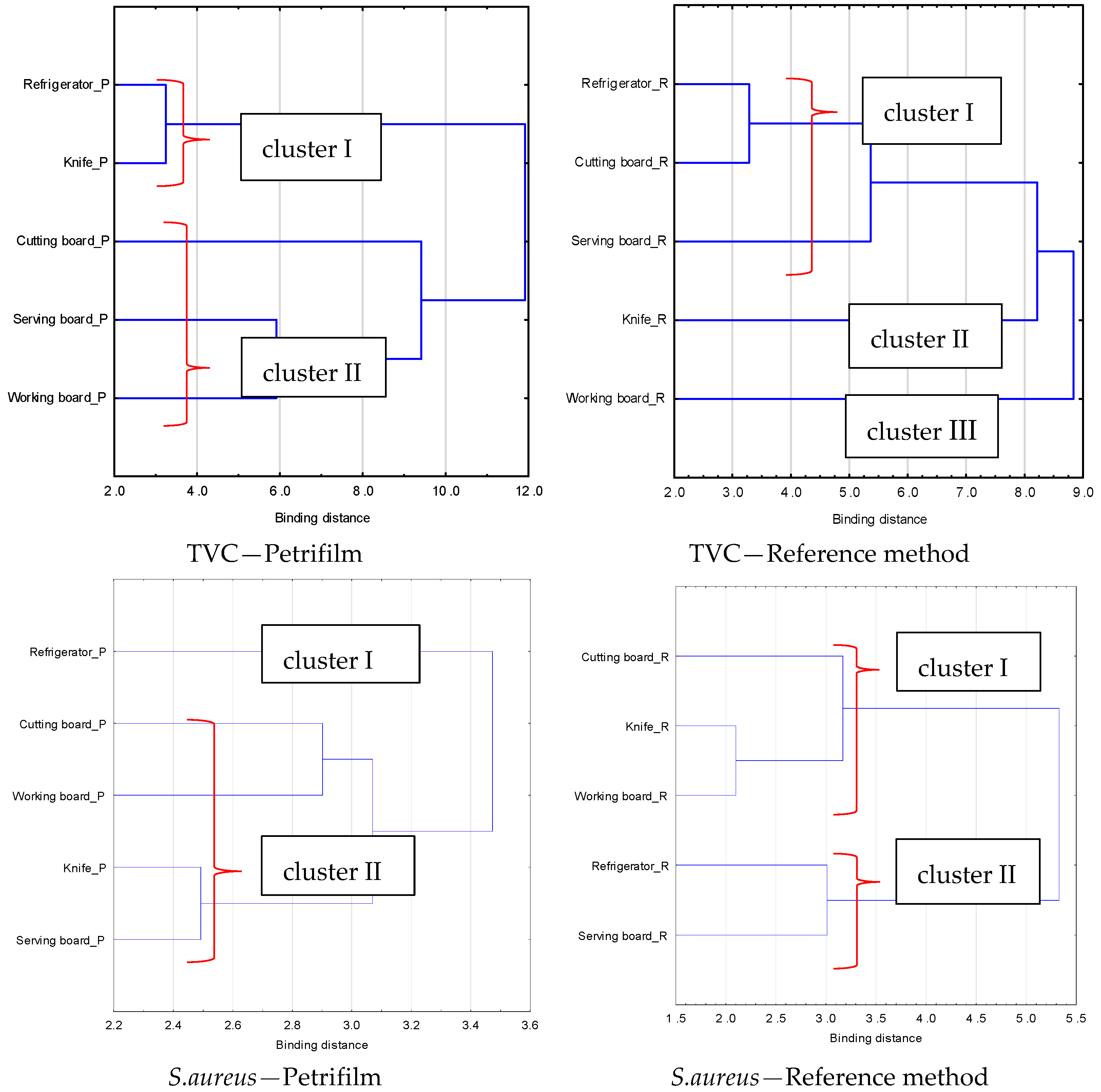
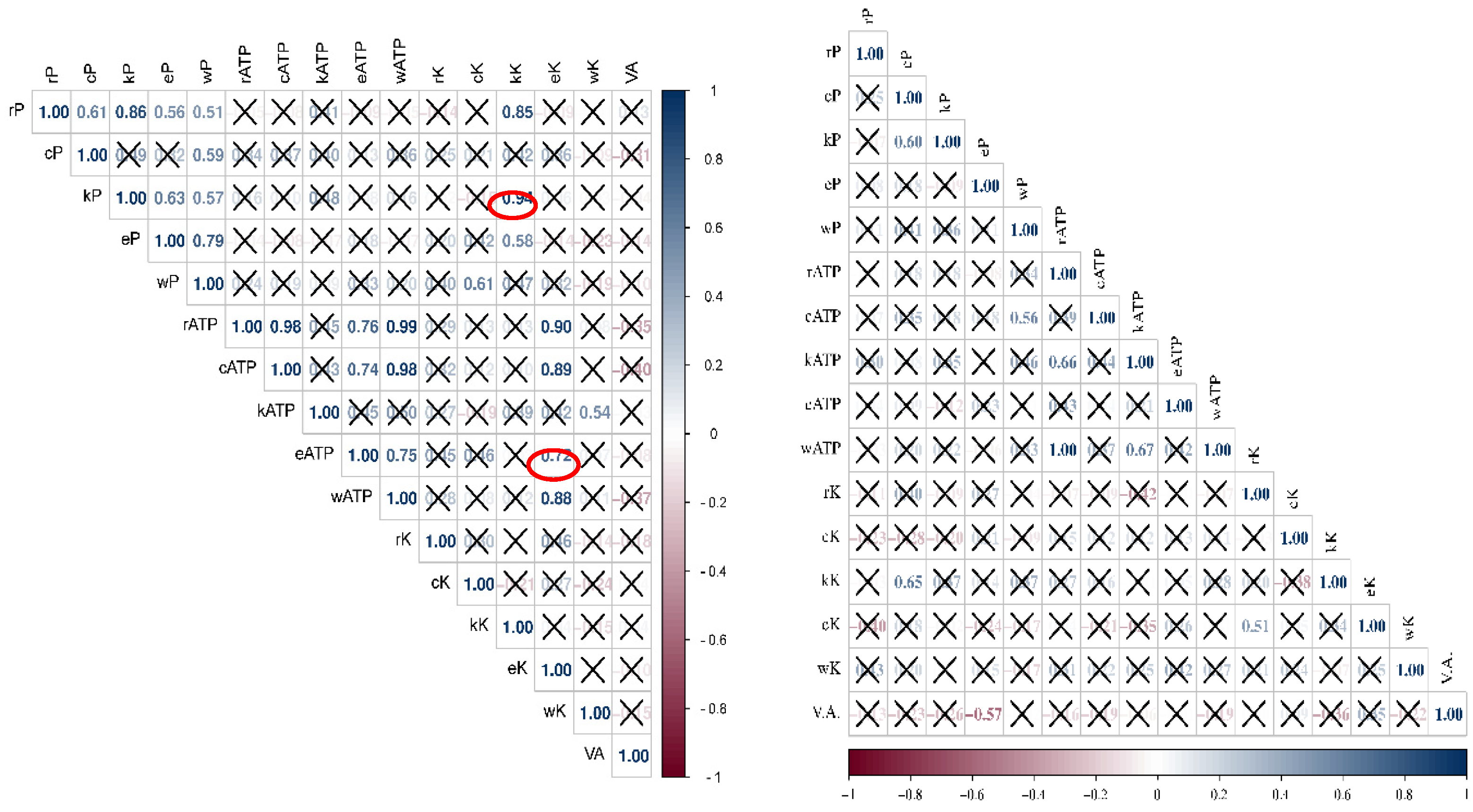
| Kind of Microorganisms | Medium/Producer | ISO Standard | Typical Growth of Colonies |
|---|---|---|---|
| Total Viable Count (TVC) | NUTRIENT AGAR/ Neogen Co., Heywood, UK | [76] | All colony beside of shape, colour, size |
| Staphylococcus aureus | BARID PARKER/ BioRad, Watford, UK | [77] | Black-grey with transparent halo |
| Enterobacteriaceae | VRBG/ Oxoid Ltd., Hampshire, UK | [78] | Pink-violet |
| Escherichia coli | TBX/Oxoid Ltd., Hampshire, UK | [79] | Blue-green |
| Listeria monocytogenes | AL OA, PALCAM/ Neogen Co., Heywood, UK | [80] | Blue-green with cloudy halo; olive-grey with black centre |
| Salmonella spp. | BGA, XLD/Neogen Co., Heywood, UK | [81] | Black, red, pinkish, or white with red halo |
| Type of Petrifilm (Surface cm2) | Kind of Microorganisms | Medium Composition | Incubation Conditions | Typical Colonies |
|---|---|---|---|---|
| PAC (20) | TVC | Nutrient agents, tetrazol indicator | 30 °C, 72 h | Pink-red |
| STX (30) | Staphylococcus aureus | Baird-Parker medium | 35–37 °C, 24 h | Intensive red-purple |
| EL (40) | Environmental Listeria spp. | Selective and nutrient agents, chromogenic indicator | 37 °C 26–30 h | Grey-purple |
| EB (20) | Enterobacteriaceae | VRBG medium | 37 °C 24 h | Red with gas bubbles or with yellow acid zone or both |
| EC (20) | Escherichia coli and coliforms | VRBL medium | 35–44 °C, 24–48 h | Blue or red-blue with gas bubble |
| No. FT | Kind of Offer | Surface Details | Score of Visual Assessments * |
|---|---|---|---|
| FT1 | Pizza | The surfaces in the food truck were new, composed of stainless steel and plastic; a round knife designed for cutting pizza was used for evaluation. | 5 |
| FT7 | Fried chicken | All surfaces were clean and well maintained. The cutting board was composed of hard plastic. | 5 |
| FT12 | Casseroles | All surfaces were of very good quality and cleanliness; cleaning took place just before testing. | 5 |
| FT4 | Thai meals | In food truck, the equipment and surfaces were new, but not properly maintained; there were visible traces of dirt from the previous day’s work. | 4 |
| FT5 | Greek meals | The food truck was not new; there were signs of contamination; however, all surfaces and equipment were in good condition—no visible signs of dirt, etc. | 4 |
| FT8 | Burgers | In the food truck, most of the surfaces were clean and well maintained. The food truck was freshly renovated, but the cutting knives were dirty (there were visible traces of their previous use). | 4 |
| FT9 | Burgers | Equipment and surfaces were maintained in good condition and clean. The cutting board was composed of the wrong material (wooden). | 4 |
| FT11 | Casseroles | The working surfaces, as well as the production equipment, were kept in good condition. The consumer areas (3 tables) were not clean; they had not been cleaned the day before. | 4 |
| FT16 | Burgers | All surfaces were of average quality; it was evident that they had been intensively used, but there was no visual dirt. | 4 |
| FT17 | Burgers | All surfaces were of average quality; it was evident that they had been intensively used, but there was no visual dirt. | 4 |
| FT18 | Burgers | All surfaces were of average quality; it was evident that they had been intensively used, but there was no visual dirt. | 4 |
| FT19 | Burgers | All surfaces were of average quality; it was evident that they had been intensively used, but there was no visual dirt. | 4 |
| FT20 | Burgers | All surfaces were of average quality; it was evident that they had been intensively used, but there was no visual dirt. | 4 |
| FT10 | French fries | The surfaces from which the swab was taken were not of poor quality, whereas the other surfaces were dirty. It was noticed that the “old” frying oil was to be used (there were visible remnants of previous frying, the colour of oil was dark orange). | 3 |
| FT13 | Ice cream | There were visible marks of raw material remaining after previous work the day before. The condition of the surfaces was average; defects in surface quality and cleanliness were visible. | 3 |
| FT15 | Burgers | In the food truck, most of the surface was kept in good condition, except for the fridge; dirt and raw material residues were visible. | 3 |
| FT2 | Israeli meals | The surfaces, which were composed of wood and plastic, had traces of many years of use. | 2 |
| FT3 | Burgers | Inside the food truck, it was clear that there had been many years of operation without renovation; the walls were covered with dried fat. Small equipment, i.e., a cutting board and knives, were newly purchased. | 2 |
| FT14 | Burgers | The equipment used in the street food outlets was not of good quality; the electric grill showed traces of burnt fat, the small appliances were of better quality (there were no visible signs of dirt), and the cutting board was composed of bamboo and was very wet | 2 |
| FT6 | Ramen | The surfaces were new but not clean; traces of use were visible. The cutting board was composed of compressed bamboo; the worktops were composed of stainless steel. | 1 |
| Method/Analysis | Food Truck (FT) * | Sum | |||||||||
|---|---|---|---|---|---|---|---|---|---|---|---|
| 1 | 2 | 3 | 4 | 5 | 6 | 9 | 10 | 11 | 12 | ||
| Petrifilm/Enterobacteriaceae | |||||||||||
| >1 log CFU | 2 | 2 | 2 | 2 | 2 | 1 | - | 2 | 2 | 15 | |
| 1–2 log CFU | 2 | 3 | - | - | - | - | - | - | - | - | 5 |
| <2 log | - | - | - | - | - | - | - | 5 | - | - | 5 |
| Petrifilm/E. coli | |||||||||||
| >1 log CFU | 2 | 1 | - | - | - | - | - | - | - | - | 3 |
| 1–2 log CFU | 2 | - | - | - | - | - | - | - | - | - | 2 |
| Reference/Enterobacteriaceae | |||||||||||
| >1 log CFU | 2 | 3 | 1 | 1 | 1 | - | - | - | - | - | 8 |
| 1–2 log CFU | 1 | - | - | - | - | - | - | - | - | - | 1 |
| Reference/E. coli | |||||||||||
| >1 log CFU | - | - | - | - | - | - | - | - | - | - | 0 |
| 1–2 log CFU | 2 | - | - | -- | - | - | - | - | - | - | 2 |
| Sum of surfaces Enterobacteriaceae contaminated P/R Sum of surfaces E. coli contaminated P/R | 4/3 4/2 | 3/3 1/0 | 2/1 0/0 | 2/1 0/0 | 2/1 0/0 | 2/0 0/0 | 1/0 0/0 | 5/0 0/0 | 2/0 0/0 | 2/0 0/0 | |
Disclaimer/Publisher’s Note: The statements, opinions and data contained in all publications are solely those of the individual author(s) and contributor(s) and not of MDPI and/or the editor(s). MDPI and/or the editor(s) disclaim responsibility for any injury to people or property resulting from any ideas, methods, instructions or products referred to in the content. |
© 2023 by the authors. Licensee MDPI, Basel, Switzerland. This article is an open access article distributed under the terms and conditions of the Creative Commons Attribution (CC BY) license (https://creativecommons.org/licenses/by/4.0/).
Share and Cite
Wiatrowski, M.; Rosiak, E.; Czarniecka-Skubina, E. Surface Hygiene Evaluation Method in Food Trucks as an Important Factor in the Assessment of Microbiological Risks in Mobile Gastronomy. Foods 2023, 12, 772. https://doi.org/10.3390/foods12040772
Wiatrowski M, Rosiak E, Czarniecka-Skubina E. Surface Hygiene Evaluation Method in Food Trucks as an Important Factor in the Assessment of Microbiological Risks in Mobile Gastronomy. Foods. 2023; 12(4):772. https://doi.org/10.3390/foods12040772
Chicago/Turabian StyleWiatrowski, Michał, Elżbieta Rosiak, and Ewa Czarniecka-Skubina. 2023. "Surface Hygiene Evaluation Method in Food Trucks as an Important Factor in the Assessment of Microbiological Risks in Mobile Gastronomy" Foods 12, no. 4: 772. https://doi.org/10.3390/foods12040772
APA StyleWiatrowski, M., Rosiak, E., & Czarniecka-Skubina, E. (2023). Surface Hygiene Evaluation Method in Food Trucks as an Important Factor in the Assessment of Microbiological Risks in Mobile Gastronomy. Foods, 12(4), 772. https://doi.org/10.3390/foods12040772









